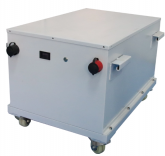svetz
Works in theory! Practice? That's something else
UPDATE: This is probably a bogus product as described. Possibly some sort of hybrid mix of a supercapitor and lithium cell.
Looks like supercapacitors have made a big graphene jump forward:
If you look at the $/lifecycle, it's almost the same cost as LiFePO4 and these are just the first generation of market-ready components.
Similarly, if you compare the kW/m^3, its the same as a prismatic cell. This is particularly important for EVs, it means in the same amount of space you can put similar energy storage at 63% the weight. Also for EVs, imagine being able to completely recharge in about the same amount of time as it does to fill a tank of gas.
It won't help folks like me who use energy storage for emergency backup and only consume a few cycles per year. But for those who cycle the batteries a lot (or want to as they have no/poor net-metering) ... oh yeah, this product really shines for off-grid solar because of the $/life-cycle and lower round-trip energy losses than LiFePO4. Ditto for public utilities for energy storage. The self-discharge is roughly the same as LiFePO4, but if you're cycling a lot that's nothing compared to the round-trip energy losses incurred by LiFePO4.
Looks like supercapacitors have made a big graphene jump forward:
| Stored Energy: 75 Wh Cost ($/Wh): 1.00 to $0.69 (bulk buy) (LiFePO4 is ~$.15/Wh) Leak current: < 20 mA Self Discharge: 3%/mo (LiFePO4 is 2-5%/mo) ESR: < 1 milliOhm Voltage: 4.2v Capacitance: 21000F -20 to +60℃ > 20,000 cycles Max continuous current: 40A Size: 220*128*7.5mm Weight: 350 G (4.6g/Wh, compared to LiFePO4 @ 7.3,g/Wh) Power volume (kW/m^3): 352 (compared to LiFePO4 prismatic @ 352.5) Ref: https://www.alibaba.com/product-detail/Graphene-Ultracapacitor-4-2V-21000F-221_62575851069.html |
If you look at the $/lifecycle, it's almost the same cost as LiFePO4 and these are just the first generation of market-ready components.
Similarly, if you compare the kW/m^3, its the same as a prismatic cell. This is particularly important for EVs, it means in the same amount of space you can put similar energy storage at 63% the weight. Also for EVs, imagine being able to completely recharge in about the same amount of time as it does to fill a tank of gas.
It won't help folks like me who use energy storage for emergency backup and only consume a few cycles per year. But for those who cycle the batteries a lot (or want to as they have no/poor net-metering) ... oh yeah, this product really shines for off-grid solar because of the $/life-cycle and lower round-trip energy losses than LiFePO4. Ditto for public utilities for energy storage. The self-discharge is roughly the same as LiFePO4, but if you're cycling a lot that's nothing compared to the round-trip energy losses incurred by LiFePO4.
Last edited:




